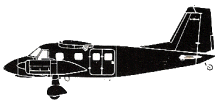Incident Overview

Description
The BN-2B Islander operated on a return flight from Roskilde Airport (RKE) to Ls? Airport (BYR) via Anholt. The return part of the flight was uneventful up to the landing at Anholt. After landing the elevator trim was not set to neutral and remained at a 1.5 unit nose down setting which had been used for landing. The pilot did not visit the airport office to obtain wind information. Instead he assessed the wind was across the runway and taxied for a runway 03 departure. In fact the current wind was a tailwind component, which was close to the maximum. On takeoff the pilot tried to raise the nose but during this rotation the aircraft nose dived uncontrolled back on runway again. He attempted a second time with the same result. At this point the pilot considered that it was not possible to stop the aircraft within runway limitations. A third rotation was initiated, whereby the aircraft was in the air immediately after the runway end, while the aircraft stall warning horn activated. The captain lowered the nose of the aircraft to build up airspeed and to avoid a stall. During this maneuver the right main undercarriage struck a sand dune with shrubs, and the airplane impacted terrain. FAKTORER 1. Luftfart?jets h?jderorstrim var ikke korrekt konfigureret til neutral. 2. Fart?jschefen afbr?d ikke starten efter den f?rste rotation, hvor luftfart?jet ikke reagerede normalt p h?jderors kommandoen. 3. Starten blev foretaget med en medvindskomponent, som var tt p den maksimale tilladte. FACTORS (unofficial translation from Danish) 1. Aircraft trim was not correctly configured to neutral. 2. The commander did not abort the takeoff after the first attempted rotation, when the aircraft did not respond normally to elevator command. 3. The start was made with a tailwind component, which was close to the maximum.
Primary Cause
Incorrect elevator trim setting during takeoff, leading to an uncontrolled nose dive.Incorrect elevator trim setting during takeoff, leading to an uncontrolled nose dive.Share on:





